Eric Bright is a Schroon Lake-based luthier with an eye for detail and a set of snorkeling gear. The wood he uses comes from the muck on the bottom of the lake; his guitars produce a timeless sound that's as soft as the ripples on the water's surface. It all takes attention, dedication, and time. Lots and lots of time.
Eric's story begins 150 years ago, when logging was big business in the Adirondacks. As timber companies competed for the forest, lakes and rivers became congested superhighways for their cargo. Massive tree trunks, stripped of their branches and foliage, were floated downriver to the mills in Glens Falls, where they were processed. Each log had several log marks pound into its end to identify the company it belonged to.
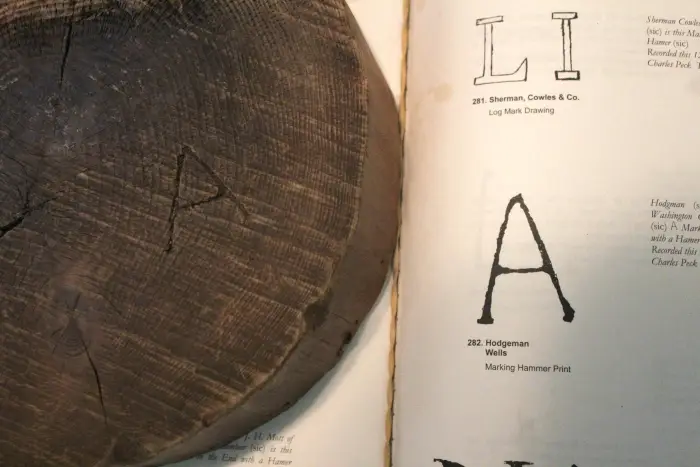
The first log drive to happen in the Adirondacks was on the Schroon River in the early 1800s. They became more commonplace as time went on, and thanks to grainy black-and-white photographs, we can take a glimpse into that chaotic scene — thousands of logs jostling for space, haphazardly arranged like wooden toothpicks scattered across the water’s surface. Most logs made the long journey to the mill, but some became submerged, sinking to the bottom of the lake where they found a new home in the soft sediment there.
Now it’s 2018, and a lot has changed. The northern end of Schroon Lake has been developed into a thriving little community filled with shops and restaurants. There’s an expansive, sandy beach that’s packed with sun-loving people all summer long, and the water is blue and shimmering. Gone are the days of logging camps and log jams, but deep below the lake’s surface the remnants of a bygone era remain — until Eric finds them.
The walls of Eric’s showroom, BassRock Guitars, are lined with about 10 guitars at any given time. Ask him and he’ll tell you their names — there’s Gloria, Rose, and Lila Grace. Each is as beautiful as its neighbor, all are carefully designed and handcrafted by Eric, in his workshop across the lake. Before they get there, though, the wood used to make them has to be pulled from the depths of Schroon Lake.
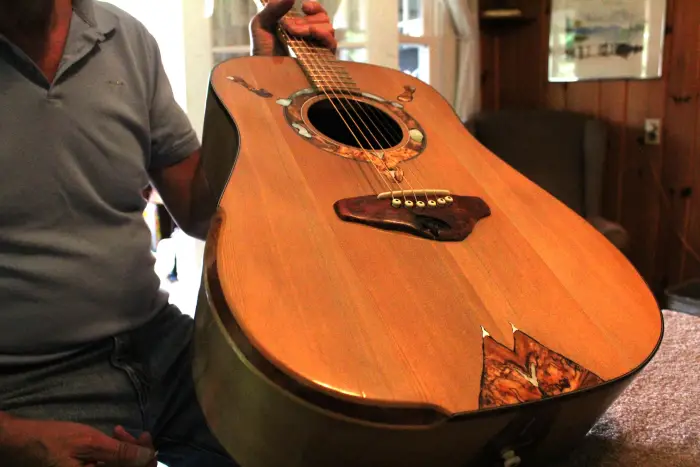
Going deep
The logs Eric uses are called sinkers, and he generally pulls them from water that’s about 10 feet deep. Once he’s found one that’s the right size, just over 13 feet and at least 14 inches in diameter, he holds his breath and dives to it with a heavy rope. Working quickly, he works his arms into the sediment and loops the rope around the trunk. That creates a cloud of debris, so if he goes up for air before the rope is in place he has to wait for the cloud to settle before heading back down.
Once the rope is secure, Eric returns to the boat and, with the help of his daughter, pulls the line taut. Then they wait.
“There’s a lot of suction down there, so Kate drives the boat until the rope is taut and we wait a few minutes," Eric said. "When the butt end of that log pops up, we tow it back to shore."
The waterlogged logs are left to air dry, then Eric’s friend cuts them down to size. Sometimes the wood is maple, other times it’s red spruce, a species that was made the gold standard for guitars by Martin Guitars.
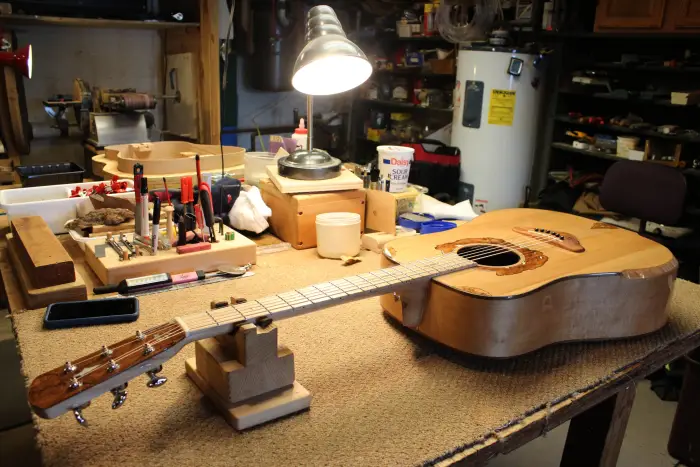
Eric says the variety is good because hardwoods like maple make the best guitar bodies, and softwoods like spruce make the best guitar faces. The different types of wood add to the aesthetics of the finished instrument, but the hardwood-softwood combo gives the guitar its voice.
“A good guitar is a machine; there are lows, mids, and highs,” Eric said. "The sides and back have to be a hardwood because there's 180 pounds of pressure on the bridge, but the top is the most important part of the sound."
Eric taps around the softwood face of a guitar and listens for the clear notes it emits. To hear him describe it, a guitar is like a living thing. Each individual instrument has its own nuanced tones, which eventually adapt to its owner’s playing style. The vibration of the strings interacts with the grain of the wood, and the instrument evolves and grows as it’s strummed.
“Some people say if you play a certain style the guitar will learn to resonate that way," Eric said. "It sounds a little extreme but it makes a little sense, too. You are teaching the guitar how you play."
A workshop with a view
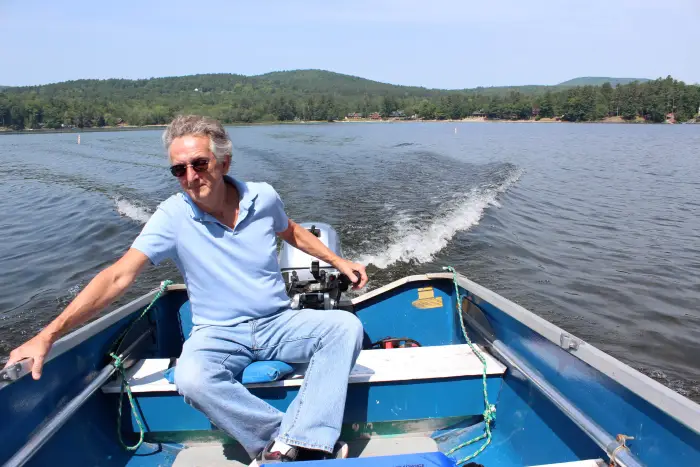 It’s a short walk to the shore of Schroon Lake from the BassRock Guitars showroom. From the long wooden dock it’s a 5-minute trip by motorboat to Eric’s workshop, a roomy basement space overlooking the water that’s packed full of tools and wood. There are forms for guitar faces and bodies, labeled stacks of wood, and collections of wood burls. The burls are natural, knobby formations that grow on trees. Often used to make tables and bowls, Eric likes how their irregular features add a distinct touch to his guitars. He often uses them for the bridge, the part of the guitar that holds the strings to the face.
It’s a short walk to the shore of Schroon Lake from the BassRock Guitars showroom. From the long wooden dock it’s a 5-minute trip by motorboat to Eric’s workshop, a roomy basement space overlooking the water that’s packed full of tools and wood. There are forms for guitar faces and bodies, labeled stacks of wood, and collections of wood burls. The burls are natural, knobby formations that grow on trees. Often used to make tables and bowls, Eric likes how their irregular features add a distinct touch to his guitars. He often uses them for the bridge, the part of the guitar that holds the strings to the face.
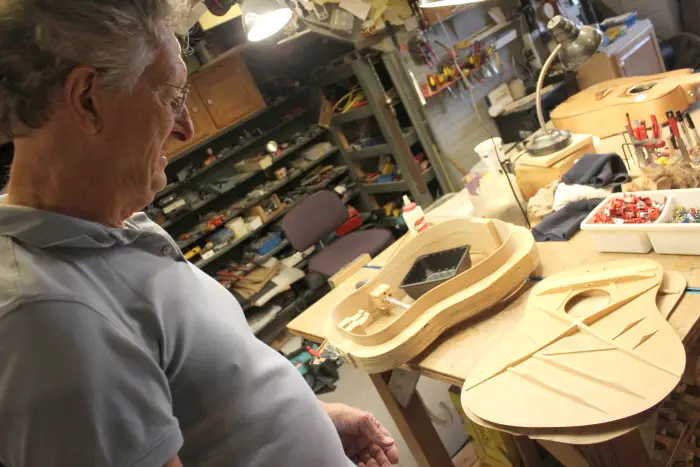
He looks for irregular grain patterns, too, and sees them as an opportunity to give the instrument it’s own personality. Sometimes he fills small holes with pieces of burl, other times he brings in mother of pearl. It all depends how the wood speaks to him.
"A new guitar, you might have grain from the spruce going in one direction and grain from the hex bracing going the other way, so they could be fighting each other," Eric said. "But what happens over time, as the guitar opens up, is all of the grain learns to resonate together. After awhile it resonates as one piece of wood."
If you hit the town after a day of hiking or paddling in the Schroon Lake Region, you might see Eric playing with his band, The Log Jammers. To see his guitars, make an appointment with BassRock Guitars.




